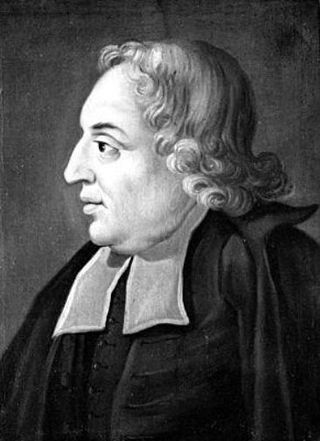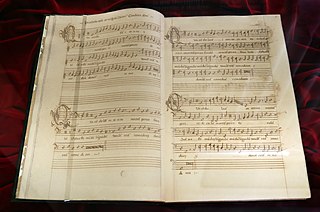(Gian) Giacomo Carissimi was an Italian composer and music teacher. He is one of the most celebrated masters of the early Baroque or, more accurately, the Roman School of music. Carissimi established the characteristic features of the Latin oratorio and was a prolific composer of masses, motets, and cantatas. He was highly influential in musical developments in northern European countries through his pupils, like Kerll in Germany and Charpentier in France, and the wide dissemination of his music.

Carlo Innocenzo Frugoni was an Italian poet and librettist. As a poet Frugoni was one of the best of the school of the Arcadian Academy, and his lyrics and pastorals had great facility and elegance. His collected works were published at Parma in 10 volumes in 1799, and a more complete edition appeared at Lucca in the same year in 15 volumes.

Giuseppe Torelli was an Italian violist, violinist, teacher, and composer of the middle Baroque era.

Giacomo Antonio Perti was an Italian composer of the Baroque era. He was mainly active at Bologna, where he was Maestro di Cappella for sixty years. He was the teacher of Giuseppe Torelli and Giovanni Battista Martini.

Tommaso Michele Francesco Saverio Traetta was an Italian composer of the Neapolitan School. Along with other composers mainly in the Holy Roman Empire and France, he was responsible for certain operatic reforms including reducing the ornateness of style and the primacy of star singers.

Carlo Alessandro Guidi, Italian lyric poet, was born at Pavia.
Francesco Onofrio Manfredini was an Italian Baroque composer, violinist, and church musician.

Egidio Romualdo Duni was an Italian composer who studied in Naples and worked in Italy, France and London, writing both Italian and French operas.
Marco Uccellini was an Italian Baroque violinist and composer. His output of mainly secular music for solo violin is considered to have been important in the rise of independent instrumental classical music, and in development of violin technique.
The decade of the 1540s in music involved some significant events.

Francesco Corteccia was an Italian composer, organist, and teacher of the Renaissance. Not only was he one of the best known of the early composers of madrigals, and an important native Italian composer during a period of domination by composers from the Low Countries, but he was the most prominent musician in Florence for several decades during the reign of Cosimo I de' Medici.

Cataldo Vito Amodei was an Italian composer of the mid-Baroque period who spent his career in Naples. His cantatas were important predecessors to the active cantata production of 18th-century Naples, and he stands with the elder Francesco Provenzale and younger Alessandro Scarlatti as among the principal Italian cantata composers. Other surviving works include a book of motets dedicated to Leopold I, Holy Roman Emperor; a serenata; two pastorales; two psalms; and four oratorios, which were important contributions to their genre.
Ippolito Chamaterò was an Italian composer of the late Renaissance, originally from Rome but active in northern Italy. He wrote both sacred and secular music, particularly madrigals; all of his surviving music is vocal. His sacred musical style was in conformance with the Counter-Reformation musical ideals following the Council of Trent, and his madrigals were related stylistically to those of Adrian Willaert and Cipriano de Rore.
Giuseppe de Majo was an Italian composer and organist. He was the father of the composer Gian Francesco de Majo. His compositional output consists of 10 operas, an oratorio, a concerto for 2 violins, and a considerable amount of sacred music.

Gian Francesco de Majo was an Italian composer. He is best known for his more than 20 operas. He also composed a considerable amount of sacred works, including oratorios, cantatas, and masses.
Francesco Maria Bazzani or Bassani was an Italian baroque composer.
La passione di Gesù Cristo is a libretto by Pietro Metastasio which was repeatedly set as an azione sacra or oratorio by many composers of the late baroque, Rococo and early classical period.

The Chapel Royal of Naples was the sacred musical establishment of the Spanish court in Naples which began with the Aragonese Court of Naples, and continued under the Habsburgs the Bourbons, and Joseph Napoleon.
Ghirlanda sacra scielta da diversi eccellentissimi compositori de varii motetti à voce sola is a compilation of 44 single-voice motets in the new style assembled by Leonardo Simonetti. Simonetti was a chorister in the Cappella Marciana, and placed his master Claudio Monteverdi at the head of the collection with four pieces, following it with other composers from the area of Venice and Veneto. A second printing followed in 1636.
Giovanni Perroni was an Italian cellist and composer. His known works include eight oratorios, three operas, a song cycle, and a cello concerto. His Cello Concerto in D minor premiered in Vienna in 1712 and consists of three movements: Grave - Allegro - Grave - Allegro, Grave , and Grave - Allegro. The work remains part of the cello concert repertoire.










